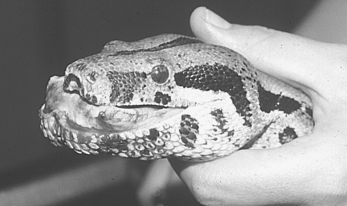Chapter 39 Diseases of the Digestive System
SNAKES
Snakes are frequently seen in the clinic for digestive problems.
Infectious Stomatitis
Infectious stomatitis, commonly called “mouth rot,” is a frequently seen problem in captive snakes (Fig. 39-1). This is not a primary disease, but rather is usually secondary to stress, trauma, or husbandry problems such as overcrowding, low environmental temperatures, and poor nutrition. Suppression of the immune system in snakes kept in inappropriate conditions allows for opportunistic pathogens to infect the oral tissues.

Figure 39-1 Infectious stomatitis is a problem in all reptiles but is most commonly seen in snakes.
(From Mader DR: Reptile medicine and surgery, ed 2, St Louis, 2006, Saunders, by permission.)
Diarrhea
Intestinal Parasites
Almost every snake will harbor some type of internal parasite when purchased. These parasites typically have very involved life cycles that the technician should review. Captive snakes are, by nature of their habitat, exposed to a greater parasite load than snakes in the wild, creating a greater problem. These animals have higher stress levels that result in immunosuppression, again predisposing them to parasite infestation. Some of the most frequently found intestinal parasites of snakes are listed in Box 39-1. As shown in Box 39-1, parasitic infection in snakes can involve multiple organisms. Parasitized animals are unthrifty, have shorter life spans, and may act as a reservoir for human infestation.



